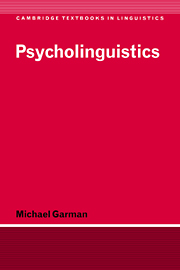Summary
This book provides an introduction to the field of language study known as psycholinguistics. Language can be studied in a number of ways – as a corpus of data in descriptive linguistics, as an abstract system of knowledge in theoretical linguistics, as a social phenomenon in sociolinguistics, and so on. Psycholinguistics is, as its name implies, basically concerned with language as a psychological phenomenon; and, most characteristically, with language in the individual. Hence it addresses such questions as ‘How does a listener recognise words in the stream of speech, or in patterns on the page, and arrive at an understanding of utterances?’ and ‘How does a speaker go about putting ideas into forms that can be expressed as patterns of articulatory, or manual, movements?’
Two important aspects of these concerns are well captured in the term microgenesis of language (Campbell 1979). First, micro- in this connection refers to the rapid, moment-by-moment nature of everyday language processes, by virtue of which we understand and produce utterances on a time scale that is marked off in seconds and milliseconds. This contrasts with what we may refer to as the macrogenesis of language, in either of its main forms, (i) the individual's learning of a first or subsequent language (the ontogenesis of language), on a time scale of days, weeks, months and years or (ii) in the species' development of linguistic abilities (the phylogenesis of language), on a time scale appropriate to human evolution.
- Type
- Chapter
- Information
- Psycholinguistics , pp. xiii - xviPublisher: Cambridge University PressPrint publication year: 1990

